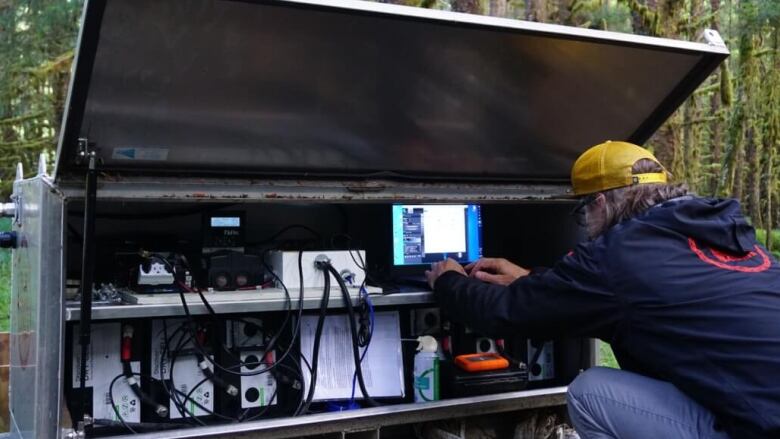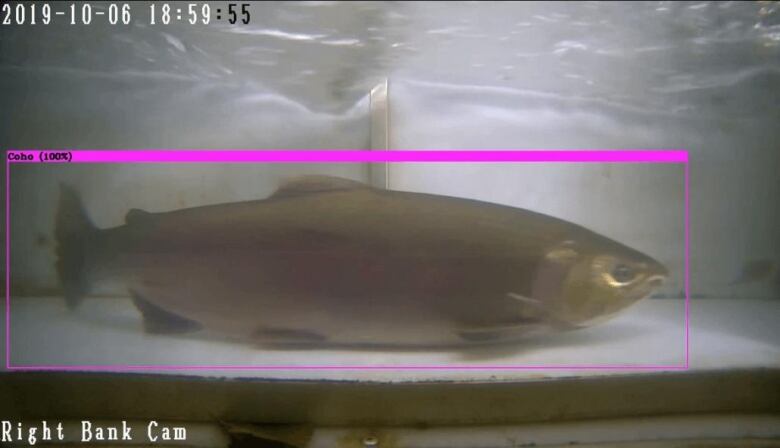First Nations harness power of AI to monitor wild salmon stocks in B.C.
The technology can differentiate species and provide accurate fish counts to inform harvesting practices

With salmon returning to rivers across British Columbia right now,counting their numbers accurately is critical for conservation efforts and artificial intelligenceis proving it has thepotential to help.
Spawning salmon are usually counted by teams of volunteers, or monitored with in-river video.
Now, AI technology developed in partnership with conservation groups, Simon Fraser University, and First Nations on B.C.'s North and Central coastsis being usedto sort through that footage to differentiate between species.
The results of a pilot study,recently published inFrontiers in Marine Science, show that thecomputer vision deep learning model which is being called 'Salmon Vision'was about 90 per cent accuratewhen it came to detecting coho and 80 per cent accuratefor sockeye after reviewing more than 500,000 video frames.

"The AI comesin the form of tracking and identifying every fish that swims past our video camera," saidWill Atlas, a scientist with the Wild Salmon Center and lead author of the report.
"So, essentially the AI is fulfilling the role that a technician would otherwise fill, spending often times four or five months reviewing the video before we have the final count."
The data sets were taken from weirs built in the Skeena River watershed.
Weirs are an ancient First Nations device a small, man-made,dam-like structuredesigned to capture fish on the edge of a waterway.
Used traditionally for harvesting, they were employed for monitoring during the pilot project and provided the results for the report.
Atlas said the next step is to employ AI technology widely in the field, especially because the province's extensive water systems, combined with the impacts of climate change, make it challengingand increasingly criticalto get accurate fish counts.
"One of the most exciting things about it is that it will be providing in season real-time information on how many salmon come through which can help guide much more precautionary and data informed fishing decisions," he said, speaking on CBC's The Early Edition.
AI 'increases a lot of our capacity'
William Housty, associate director for the Heiltsuk Integrated Resource Management Department, is excited about harnessing AI technology in a weir in theKoeye Riverwhich runs through the nation's territories on the central coast of B.C.
He said AI increases the quality of data collected and can helpthe Heiltsuk Nation to make better decisions, and have stronger governance,when it comes to managing sockeye on their land.

"It's really an extension of title and rights over the the ability to manage salmon systems and allows us to develop management plans that are based on real data and with a very low confidence of error and so it's a great fit for us," said Housty, also speaking onThe Early Edition.
He said there has been a steady decline in salmon stocks over the last several decades and there has been limited data to work with.
The speed and efficiency of AI, he said, means datacan be analyzed far faster than a human could,and provide critical informationthat couldhelp the struggling fish.
"It definitely increases a lot of our capacity for the nation and field technician and if [we] have some of this work happening through AI, it allows our crews to focus more efforts on other areas that we normally wouldn't have time to get to," said Housty.
The Wild Salmon Centeris currently working with the Pacific Salmon Foundation and multiple First Nations with the hope that, according to Atlas, the technology will be operating at numerous sites in the next couple of years.
The project was funded through the British Columbia Salmon Restoration and Innovation Fund, which is a Fisheries and Oceans Canada program.

With files from The Early Edition













_(720p).jpg)


 OFFICIAL HD MUSIC VIDEO.jpg)
.jpg)



























































































